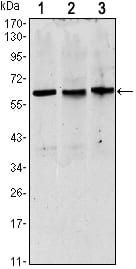
| WB | 1/500 - 1/2000 | Human,Mouse,Rat |
| IF | 咨询技术 | Human,Mouse,Rat |
| IHC | 咨询技术 | Human,Mouse,Rat |
| ICC | 技术咨询 | Human,Mouse,Rat |
| FCM | 咨询技术 | Human,Mouse,Rat |
| Elisa | 1/10000 | Human,Mouse,Rat |
| Aliases | PAX8 |
| Entrez GeneID | 7849 |
| clone | 2D4 |
| WB Predicted band size | 60kDa |
| Host/Isotype | Mouse IgG1 |
| Antibody Type | Primary antibody |
| Storage | Store at 4°C short term. Aliquot and store at -20°C long term. Avoid freeze/thaw cycles. |
| Species Reactivity | Human |
| Immunogen | Purified recombinant fragment of human PAX8 expressed in E. Coli. |
| Formulation | Ascitic fluid containing 0.03% sodium azide. |
+ +
以下是关于PAX8抗体的3篇参考文献及其摘要内容的简要总结:
1. **文献名称**:*PAX8 Immunostaining in Renal Cell Carcinoma and Other Tumors: A Systematic Review*
**作者**:Al-Ahmadie HA, et al.
**摘要**:该研究系统回顾了PAX8抗体在肾细胞癌及其他肿瘤中的表达模式,证实其在肾透明细胞癌和卵巢癌中的高特异性(>90%),并强调了其与PAX5的区别性表达,可作为鉴别诊断工具。
2. **文献名称**:*Utility of PAX8 and PAX2 Immunohistochemistry in the Diagnosis of Thyroid and Renal Tumors*
**作者**:Bishop JA, et al.
**摘要**:研究评估了PAX8抗体在甲状腺癌(乳头状癌和滤泡癌)及肾肿瘤中的诊断价值,发现其在甲状腺癌中的阳性率高达95%,而在非甲状腺/肾来源肿瘤中极少表达,支持其作为特异性标记物。
3. **文献名称**:*PAX8 Expression in Ovarian and Endometrial Carcinomas: A Comparative Study*
**作者**:Nonaka D, et al.
**摘要**:该文献比较了PAX8在卵巢癌和子宫内膜癌中的表达差异,发现卵巢浆液性癌中PAX8阳性率超过80%,而子宫内膜样癌阳性率较低,提示其在卵巢癌鉴别诊断中的重要性。
以上文献均聚焦于PAX8抗体在肿瘤病理诊断中的应用,涵盖甲状腺、肾脏、妇科肿瘤等领域,并强调其高特异性及与其他标记物的互补作用。
PAX8 (Paired Box 8) is a transcription factor encoded by the *PAX8* gene, belonging to the PAX family of proteins critical during embryonic development. It plays a vital role in organogenesis, particularly in the urinary system (kidneys) and the thyroid gland, where it regulates cell differentiation and tissue-specific gene expression. In diagnostic pathology, PAX8 antibodies are widely used as immunohistochemical markers to identify tissues and tumors derived from these organs.
PAX8 expression is strongly associated with epithelial cancers, including ovarian carcinomas (e.g., serous and endometrioid subtypes), renal cell carcinomas, and thyroid carcinomas (e.g., papillary and follicular types). Its nuclear staining pattern helps distinguish these malignancies from morphologically similar tumors, aiding in differential diagnosis. For instance, PAX8 is often positive in Müllerian-origin tumors but negative in gastrointestinal or lung adenocarcinomas, making it valuable in determining the primary site of metastatic cancers.
Research also explores PAX8's role in tumorigenesis, as its dysregulation may contribute to cancer progression. While highly sensitive, PAX8 is not entirely specific; occasional expression is observed in other neoplasms (e.g., neuroendocrine tumors). Nonetheless, it remains a cornerstone in surgical pathology, often used alongside other markers (e.g., PAX2. TTF-1) to refine diagnostic accuracy. Recent studies further investigate its prognostic implications and therapeutic targeting potential.
×